
This is the final article relating Dr. Alan Stern’s lecture on the importance of the Kuiper Belt and how it helped astronomers to re-examine their views about the Solar System [see part 1, “Pluto and the Three-Zoned Solar System,” by Douglas Warshow, May 2009 and part 2, “Kuiper Belt Objects and the Re-Organization of the Solar System,” by Douglas Warshow, October, 2009 ]. The rest of this piece concerns one such re-examination that almost everyone has heard about by now: the definition of the word “planet.”
In the interest of full disclosure, the author would like to point out that he agrees with Dr. Stern’s conclusions and the reader may rightly point to some bias in this piece. Nevertheless, the author will try to present Dr. Stern’s train of thought on this matter as dispassionately as possible. The author also asks the reader to refrain from killing the messenger (literally and figuratively); this article is merely a report (with some added background) on the relevant portion of Dr. Stern’s lecture.
The term “planet” comes from an ancient Greek word (![]() )
meaning “wanderer.” This was a reference to the fact
that these objects moved through the sky against the background of fixed stars.
)
meaning “wanderer.” This was a reference to the fact
that these objects moved through the sky against the background of fixed stars.
Several centuries later, the astronomer Galileo Galilei turned his telescope to Jupiter and saw that there were other bodies that moved with respect to the sky. Although he called them the “Medician stars,” he knew that they were actually moons orbiting the King of the Planets.
Other wandering bodies such as Uranus, Neptune, Pluto, the asteroids, comets and the Kuiper belt objects (KBOs) became known to humanity throughout history. As had mentioned in the first of these articles, the size range of the KBOs with respect to Pluto and the other major bodies of the Solar System highlighted the fact that no scientific criteria had ever been assigned to the word “planet.” As to augment this point even further, astronomers in the last decade have been discovering many (now well over three hundred) large bodies orbiting other stars. Clearly something had to be done.
A clear consensus on the definition, however, was not in the stars. Debates raged both within and without the astronomical community, especially with respect to the status of Pluto. And although Pluto became the crux of the issue, the outcome would also affect the designations of the KBOs.
In 2006, a gathering of the International Astronomical Union (IAU) debated as to what criteria should be used in order to determine whether or not an object was a planet. In the end, they presented the following definition*:
“A planet is a celestial body that
(a) is in orbit around the Sun,
(b) has sufficient mass for its self-gravity to overcome rigid body forces so that it assumes a hydrostatic equilibrium (nearly round) shape, and
(c) has cleared the neighbourhood around its orbit.”
Furthermore, a non-satellite body fulfilling only the first two criteria would be classified as a “dwarf planet,” while a non-satellite body fulfilling only the first prerequisite would be termed a “small Solar System body.”
Many astronomers (and laypeople) did not consider this definition as successful. And not just for emotional reasons.
As mentioned earlier, there are over three hundred known bodies that are larger than Earth orbiting other stars, so part (a) of the resolution already shows a lack of deep thought on the IAU’s part.
The major controversy, however, lies with part (c). First of all, this criterion does not reflect just a characteristic of the body in question, but also where it is with respect to all the other bodies in a planetary system. As one travels away from a star, the larger a world’s orbit is. Now add to that the fact that the farther a body is from its primary, the slower the body will travel. This combination means that over the course of any unit of time, the odds of two bodies gravitationally encountering each other decrease with increasing distance from the primary. This, in turn, means that it takes longer period of time for a “planet” to clear its neighborhood. In fact, if you were to place the Earth as far from the Sun as Pluto, then Earth would no longer be considered a planet by criterion (c) since there would be far more bodies in our neighborhood. (Mark, just think of the number of comets you could observe!). So the farther a world is from its primary, the more massive it would have to be to be considered a planet.
Another problem has to do with possible changes in the environment. Should a world’s status as planet change with time due to external factors? As an example, if a in bound comet broke up (a la Shoemaker-Levy 9) and some of the surviving fragments settled into an orbit similar to Earth’s, would Earth lose its planetary status?
A third problem involves a slight variation of the above: no world in the Solar System has cleared its orbital neighborhood. For instance, there are dozens of bodies, the Trojan asteroids, in the L4 and L5 points of the Jupiter’s orbit. By definition, the L4 and L5 points are at the same distance from the primary body (the Sun in this case) as the secondary body (Jupiter). Thus, the Trojans are in the same orbital neighborhood as Jupiter. If a world that is about a thousand times more massive than the Earth is not a planet, then what is? And what’s more, just ask the team that runs Project Spaceguard if they think that Earth’s neighborhood is clear of debris; their mission is to discover and track near-Earth asteroids in order to determine their potential hazard level for our world. They have compiled quite the list.
Dr. Stern certainly has the right to call foul in regard to the IAU’s use of the term “dwarf planet.” Stern himself coined the term back in 1991, but he used it to classify a subgroup of planets, much in the same way that dwarf stars are merely a subcategory of stars. (Stern did not mention, however, what he considered to be the upper limit for the dwarf planet subcategory.) He further indicated that the IAU’s usage of the phrase would not be considered proper English because of the disjunction in definition.
You are probably wondering why the IAU even proposed the above resolution as a basis for “planet” status. The gist of the answer is an all too familiar one.
The IAU is a bureaucratic organization of about ten thousand professional astronomers. Of these members very few are actually work in field of planetary science. The two committees within the IAU that are in charge of naming Solar System objects are the Committee on Small Body Nomenclature (in charge of naming comets and asteroids) and the Working Group for Planetary System Nomenclature (in charge of naming satellites and other non-asteroid/cometary bodies). (No commission for naming planets exists since it was though that all planets in the Solar System had already been discovered.) The two committees argued which one would get to name the bodies in the Kuiper belt, and the above definition is the result of their compromise. Since the SBN is comprised mostly of planetary dynamicists, the third criterion was added to benefit their group.
Dr. Stern assured the audience that the IAU does not have any authority to enforce their definition and that few (if any) planetary scientists have accepted it. As it is, the planetary scientists are working on their own list of criteria. There is no full consensus yet, but Dr. Stern mentioned some criteria that seem to be widely agreed upon in the planetary science community. This is what is called the Geophysical Planet Definition (GPD):
A planet
(1) does not undergo sustained fusion in its core.
(2) has sufficient mass for its self-gravity to overcome rigid body forces so that it assumes a hydrostatic equilibrium (nearly round) shape.
Notice that the position of the world plays no part in the definition. Using the above criteria, the Solar System contains twenty-five worlds. (The list is given below.)
The first criterion is the key difference between planets and stars. If you look back at part (a) of the IAU resolution, you’ll see that if the Sun were part of a binary star system, the stellar companion would be considered a planet.
In the middle ground between stars and planets are the brown dwarfs. These bodies are massive enough to fuse deuterium (also called heavy hydrogen) in their cores, but not normal hydrogen like stars do. Once their deuterium runs out, fusion stops. Since brown dwarfs do undergo sustained fusion (albeit only briefly), they would not be considered planets. Stern joked that most astronomers refer to brown dwarfs as “failed stars,” but he would call them “failed planets.”
As for the second criterion, you’ll note that this is the one criterion proposed by the IAU with which the planetary scientists actually agreed. Some bodies could be rounded by means of meteoroid or comet impacts but if those are the only reason for a body’s “roundness”, then that world is not a planet.
This begs the question, “How much mass or what minimum size is needed in order for self-gravity to make a round body?” The answer is a resounding, “That depends.” Consider: each world is comprised of different materials and in different ratios. Each material possesses a particular yield strength indicating how much pressure it can withstand before it deforms. Imagine a skyscraper built with pumice instead of steel and concrete and that should give you a good feel for the concept.
Additionally, some worlds are more porous than others. (For an extreme example, take a look at a Cassini image of Saturn’s wasp’s nest of a moon Hyperion.)
Another factor is how much the materials are differentiated within the world. A body that has all its ice in its upper layers will be more malleable under self-gravity than one which has rock interspersed throughout the ice.
Temperature is yet another factor. In general, the warmer a substance is, the easier it succumbs to gravity (like the ice-cream cake that the author once forgot to put back in the freezer).
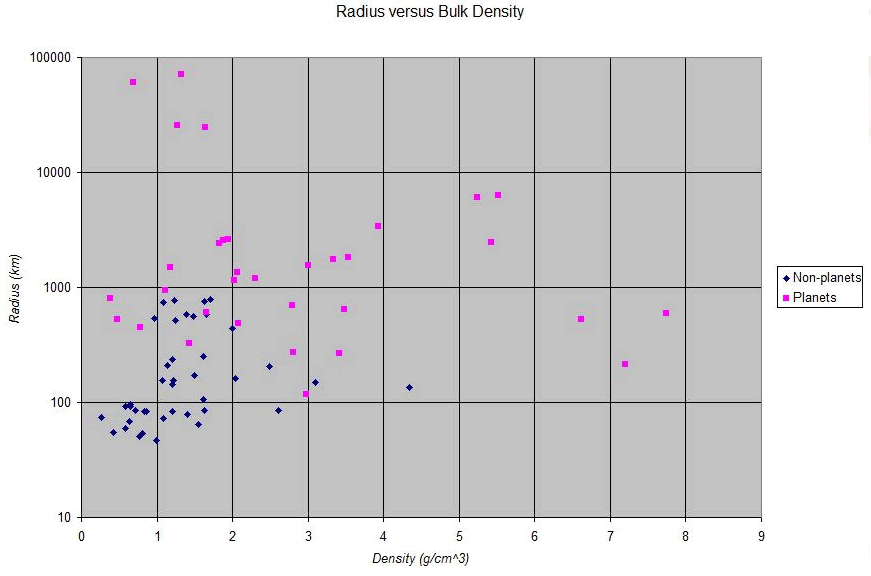
Figure 1 shows a graph of a world’s radius versus its density (similar to one shown by Dr. Stern) for several of the larger Solar System bodies. (For some worlds whose size and/or density are not well known, two extreme values are given.) Worlds that qualify as planets as per the GPD are represented by the squares.
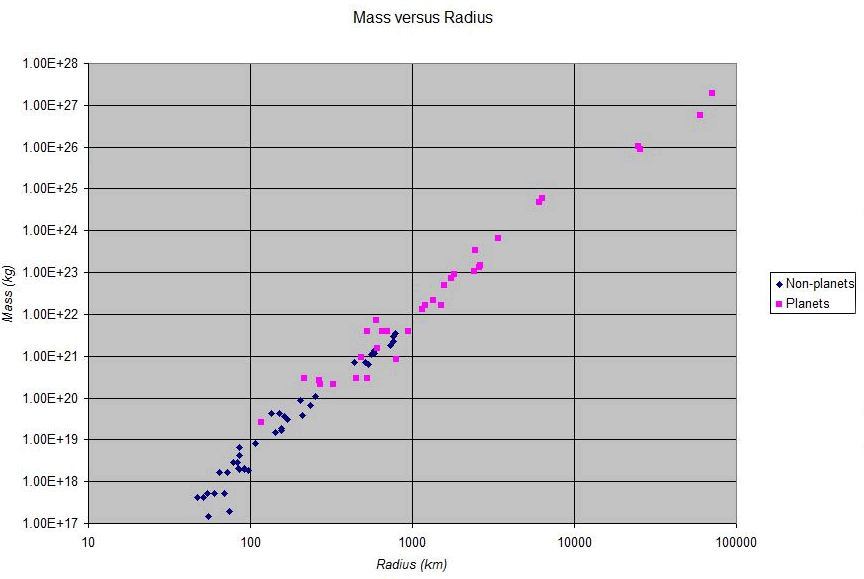
You can see a general division between the planets and non-planets in the figure, but when you compare the planets’ masses against their radii (as in Figure 2), the differences between the two groups stand out far better.
What if a satellite fulfills the aforementioned prerequisites; should it also be considered a planet? Stern says yes. So if the Earth’s moon, Luna, is planet, does that mean that the Earth is a satellite as well? Stern says no by the following reasoning.
Stern said that the definition of a moon is a body that orbits a planet. (The author confesses that he did not think to ask Dr. Stern how he would classify Dactyl, which orbits the asteroid 243 Ida, since neither meets the second criterion of the GPD.) Since all pairs of bodies orbit about their center of mass, i. e., their barycenter, the moon is considered to be orbiting about a planet if the barycenter is located within said planet.
The location of the barycenter can be determined from the following formula:
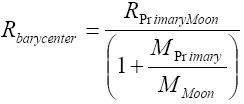
where Rbarycenter is the distance from the center of primary body, RPrimaryMoon is the distance between the centers of the primary and the orbiting body and MPrimary and MMoon are the respective masses of the primary and orbiting bodies.
For the Earth-Luna system we have:
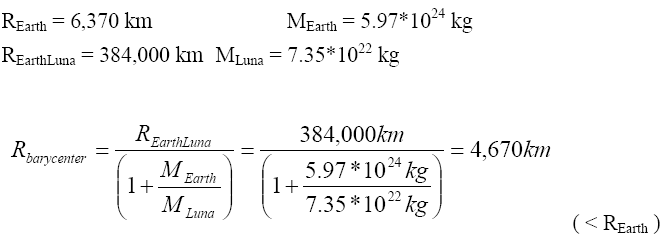
For the Pluto-Charon system we have:
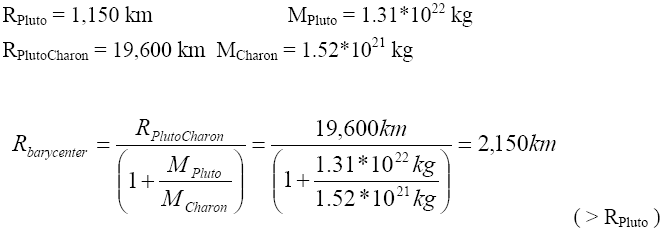
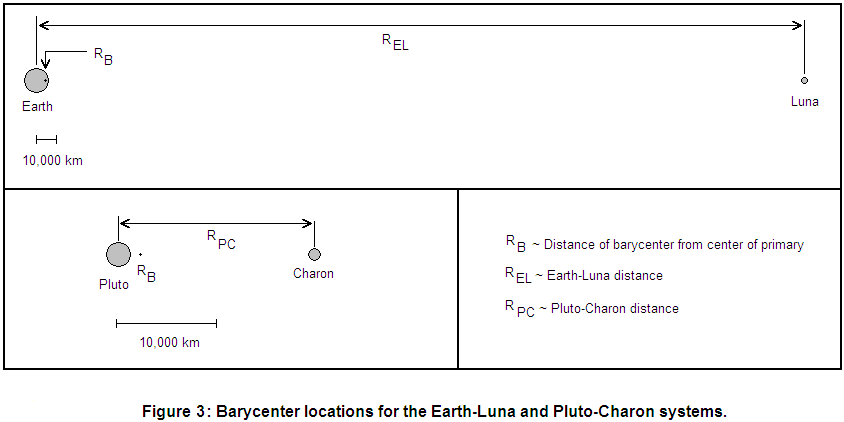
Figure 3 shows the layouts of the above examples.
Are there any other satellites besides Luna and Charon that would also qualify? You bet: Io, Europa, Ganymede, Callisto, Titan and Triton.
Now why even mention this whole debacle? Well, if we use the GPD instead of the guidelines of the IAU, Pluto retains its planetary status in addition to being a KBO. Several more KBOs can also be considered planets: 136199 Eris, 136472 Makemake and 136108 Haumea along with probable candidates 90377 Sedna, 50000 Quaoar, 28978 Ixion, 90482 Orcus and 20000 Varuna. That makes the total of twenty-five known planets in the Solar System: four terrestrials, four gas giants, nine KBOs and eight satellites. (Note: in Dd. Sterns showed a slide that listed twenty-six planets, but the author noticed when reviewing the recording of the lecture that Charon was listed twice: under both the KBO and satellite categories.)
The Kuiper belt covers a large volume so there is no reason to assume that all of the planet-sized KBOs have been found yet. The portion of the Solar System within Neptune’s, meanwhile, has been pretty much mapped out. Thus we can say there is indeed a third planetary region, one that promises to contain far many planets than the other two regions combined.
So to summarize, the discovery of Pluto and the Kuiper belt helped astronomers to re-evaluate in as far which are the most numerous types of bodies in the Solar System, how the Solar system evolved and what is meant when they use the term “planet.”
Once again, many thanks to John Causland for providing the author with a DVD of Dr. Stern’s lecture.
*IAU Resolution 5A, August 2006